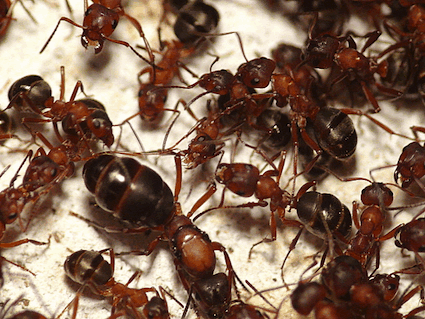On Instinct
for Slave-making by a specia Formica sanguinea
F.
sanguinea, are a facilitative slave-makers, meaning colonies can live
either alone or be parasitic. This allows them to be a good model
organism to study the origins of ant slave-making. -
Wikipedia, Formica sanguinea

Formica sanguinea with slaves
ダー ウィン『種の起源』(第6版)「第8章 本能」の中に、奴隷をつくる本能をFormica sanguinea がもっていると指摘している。
Another species, Formica sanguinea, was likewise first discovered by P. Huber to be a slave-making ant. This species is found in the southern parts of England, and its habits have been attended to by Mr. F. Smith, of the British Museum, to whom I am much indebted for information on this and other subjects. Although fully trusting to the statements of Huber and Mr. Smith, I tried to approach the subject in a sceptical frame of mind, as any one may well be excused for doubting the existence of so extraordinary an instinct as that of making slaves. Hence, I will give the observations which I made in some little detail. I opened fourteen nests of F. sanguinea, and found a few slaves in all. Males and fertile females of the slave-species (F. fusca) are found only in their own proper communities, and have never been observed in the nests of F. sanguinea. The slaves are black and not above half the size of their red masters, so that the contrast in their appearance is great. When the nest is slightly disturbed, the slaves occasionally come out, and like their masters are much agitated and defend the nest: when the nest is much disturbed, and the larvae and pupae are exposed, the slaves work energetically together with their masters in carrying them away to a place of safety. Hence, it is clear that the slaves feel quite at home. During the months of June and July, on three successive years, I watched for many hours several nests in Surrey and Sussex, and never saw a slave either leave or enter a nest. As, during these months, the slaves are very few in number, I thought that they might behave differently when more numerous; but Mr. Smith informs me that he has watched the nests at various hours during May, June and August, both in Surrey and Hampshire, and has never seen the slaves, though present in large numbers in August, either leave or enter the nest. Hence, he considers them as strictly household slaves. The masters, on the other hand, may be constantly seen bringing in materials for the nest, and food of all kinds. During the year 1860, however, in the month of July, I came across a community with an unusually large stock of slaves, and I observed a few slaves mingled with their masters leaving the nest, and marching along the same road to a tall Scotch-fir tree, twenty-five yards distant, which they ascended together, probably in search of aphides or cocci. According to Huber, who had ample opportunities for observation, the slaves in Switzerland habitually work with their masters in making the nest, and they alone open and close the doors in the morning and evening; and, as Huber expressly states, their principal office is to search for aphides. This difference in the usual habits of the masters and slaves in the two countries, probably depends merely on the slaves being captured in greater numbers in Switzerland than in England. ——出典はグーテンベルグ・プロジェクトから
邦 訳は、掘伸夫・掘大才訳『種の起源(原書第6版)』Pp.237-239、朝倉書店(2009)にある。
下 線部の邦訳は次のようになっている:「巣をちょっとかき乱すと奴隷が時折出てきて、彼らの主人と同じように騒ぎ立てて巣を防衛する。もっとひどく巣をかき 乱して幼虫と踊を外にさらすと、奴隷は主人と一緒になってそれを安全な場所へ運び去るために精力的に働く。これから見て、奴隷が自分の家にいるように感じ ていることは明らかである」(同邦訳書,p.238)
全
訳は:「もう1種、Formica sanguineaも同様に、P.
Huberが奴隷を作るアリであることを最初に発見した。この種はイングランド南部で発見され、その習性については大英博物館のF・スミス氏が研究してい
る。フーバーとスミス氏の言を全面的に信頼しながらも、私は懐疑的な心構えでこの話題に取り組もうとした。奴隷を作るというような異常な本能の存在を疑う
ことは、誰にでも十分に許されるからである。したがって、私が行った観察を少し詳しく述べることにする。フクロアカガエルの14の巣を開けたところ、全部
で数匹の奴隷を見つけた。奴隷種(F. fusca)のオスと繁殖力のあるメスは、それぞれの群落でのみ見られ、F.
sanguineaの巣で観察されたことはない。奴隷種は黒く、大きさは赤い主人の半分以下である。巣が少し乱れると、奴隷はときどき出てきて、主人と同
じように興奮し、巣を守る。巣がかなり乱れ、幼虫や蛹が露出すると、奴隷は主人と一緒になってそれらを安全な場所に運ぶために精力的に働く。従って、奴隷
たちがとてもくつろいでいることがわかる。私は3年連続で6月から7月にかけて、サリー州とサセックス州のいくつかの巣を何時間も観察したが、奴隷が巣か
ら出るのも巣に入るのも見たことがなかった。しかしスミス氏によれば、サリー州とハンプシャー州の両方で、5月、6月、8月のさまざまな時期に巣を観察し
たが、8月に奴隷が大勢いたにもかかわらず、巣を出るのも巣に入るのも見たことがないという。従って、彼は彼らを家庭内の奴隷としか考えていない。一方、
主人たちは巣の材料やあらゆる種類の餌を持ち込むのを常に目撃している。しかし1860年の7月、私は奴隷の数が異常に多い集落に出くわした。数頭の奴隷
が主人に混じって巣を出て、同じ道を25ヤード離れたスコッチ・モミの高木まで行進し、アブラムシかコクゾウムシを探しているのだろう、一緒に登っていく
のを目撃した。十分な観察の機会を得たフーバー氏によると、スイスの奴隷は主人と一緒に巣作りをするのが習慣で、朝夕は彼らだけで扉を開け閉めする。フー
バー氏が明言しているように、彼らの主な仕事はアブラムシを探すことである。両国の主人と奴隷の習慣にこのような違いがあるのは、おそらく奴隷がイギリス
よりもスイスで多く捕獲されたからにほかならない。」
私 が気になるのは次の点である。ダーウィンの描写法において、奴隷であるクロヤマアリ(Formica fusca)が擬人化(anthropomorphism) されて「感じる」(the slaves feel quite at home.)と、奴隷の心的な内面の状態を推論していることである。その前の文章では、奴隷とともに主人の巣をかき乱して、「騒ぎ立てて巣を防衛する」あるいは「運 び去るために精力的に働く」とあるが、これらは同じ擬人化でも、外部の観 察によりそのように表現することに、私たちは強い違和感をもつことはないが、この「奴 隷が自分の家にいるように感じていることは明らかである(Hence, it is clear that the slaves feel quite at home)」は、すこし特異的な描写になっている。
リ ンク
文 献
- THE
ORIGIN OF SPECIES BY MEANS OF NATURAL SELECTION, by the Project of
Gutenberg